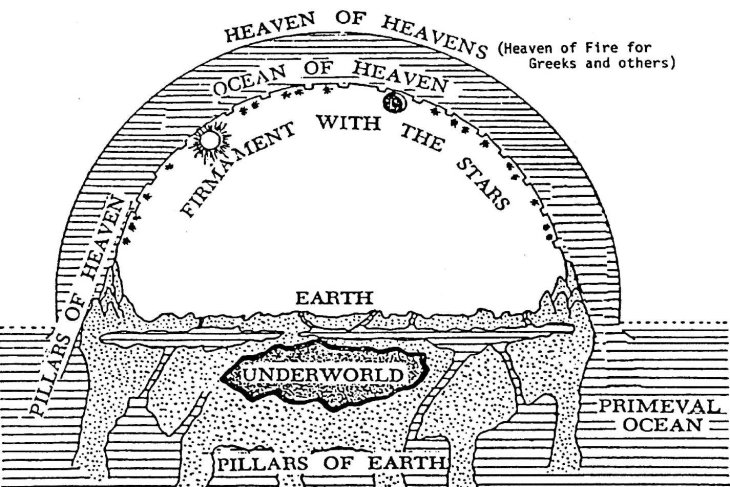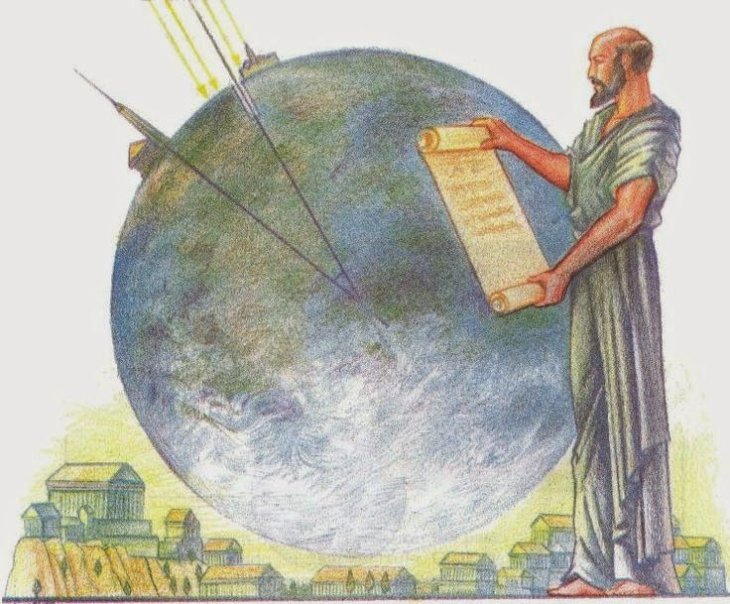How Greek Philosophers Knew That The Earth Was Round
Harin - Feb 12, 2020

The idea of a spherical Earth was floated around by Pythagoras around 500 BC and validated by Aristotle a couple of centuries later.
Early models of the Earth
Some of our earliest evidence can be found in ancient Mesopotamian imagery. As might be expected, these proposed varying forms of a flat Earth model. For example, Sumerian and Babylonian depictions portrayed the Eart as a flat disc ringed by mountains, floating on the ocean with hemispherical skyvolt resting upon the summits. This roof was punctured by small holes through which one could see the celestial fires of heaven.
The Pyramid texts of ancient Egypt which date to the old Kingdom demonstrate a similar flat Earth model with a body surrounded by eternal seas. It appears that the concepts of this early model would also leave a record in the religious ideas of the time.

For instance, the Babylonians would believe that the Earth must not only be flat but also hollow in order to provide space for their underworld. The Abrahamic religions also contain many references to their early flat Earth belief.

Greek philosophers believed that the Earth was round
For centuries, many ancient scholars from India, China, the Middle East, and Europe would continue to posit a vast array of incorrect models for the Earth’s shape. Several prominent Greek philosophers of the 5th and 6th century BC argued in favor of a curved disc or cylinder.
Among the Greeks, it was claimed that Pythagoras first to originate the idea of a spherical Earth. Born around 570 BC, he was a prominent philosopher and mathematician who contributed much to the early field of natural philosophy. We don’t know exactly how he came about his belief of the Earth’s shape. But instead of any physical evidence, his belief was based on aesthetic grounds. He, like many Greeks, believed that the most perfect shape would be the sphere.

Regardless of this, his thinking influenced many that would come after him. Plato was one such individual who learned from the Pythagorean community in Southern Italy. Upon returning home, the famous philosopher founded his school in Athens and proceeded to teach his students that the Earth was round. In his dialogue of Timaeus, for instance, Plato wrote about the properties of the universe, stating that the Earth was in the form of a globe.

While the model here is relatively accurate, we were still unfortunately kept in the dark regarding any proper scientific reasoning as Plato’s arguments are more concerned with the geometric perfection of a sphere with regards to his beliefs on cosmology in general. Luckily, Aristotle, one of Plato’s prized students would provide more details. In his work of 350 BC entitled “On The Heavens,” he laid out his astronomical theory of a geocentric universe with a fixed spherical Earth at its center.

His stated evidence includes arguments such as the rounded shadow which the Earth projects on the moon and the change in constellations as travelers voyage to Northern and Southern regions. In addition, he also referenced the effects of gravity by stating that:

Interestingly, Aristotle even directly addresses some of the arguments of contemporary flat-Earthers.

To prove this, they state that:

Thus, through the work of great thinkers like Pythagoras, Plato, and Aristotle, the round Earth belief began to gain traction. The further spread of Hellenism with the conquests of Alexander and the inquiring Romans ensured that the ideas went mainstream.
Now that the round Earth model was more commonly accepted, further inquires about the details of its shape could be made. One of the primary questions would be about its size, this would be answered by the Greek astronomer Eratosthenes in the 3rd century BC using a simple stick. His clever experiment involved measuring the angles of shadows between two distant points at the same time.

The basic idea here was that if the Sun was very far away, its rays would be hitting the Earth practically parallel to one another. Thus if the Earth was curved, the result would be a difference in the angles of shadows cast by the Sun. By measuring the difference, one could determine the radial angle between the two points. Additionally, one could also determine the arc length between the same two points by measuring the distance along the surface between them. With these two measurements, one could then use the ratio below to calculate the circumference of the Earth.

With his theory in place, Eratosthenes then went about conducting the experiment. He chose the two locations: the cities of Syene and Alexandria. The first point was Syene where he knew that at noon on the summer solstice, the Sun was directly overhead and shone down a deep well. Back in Alexandria, he planted a vertical rod at the same time of day. Using the length of the rod, the shadow and trigonometry, he calculated that the angle of the Sun’s rays was seven degrees. Using the formula, he knew that the distance between himself and Syene would be about one-fiftieth the circumference of the Earth. Eratosthenes then quickly referred to the results of surveying trips which reported the value to be 5,000 stadia. Therefore, he concluded the Earth’s circumference must be about 250,000 stadia. This value was amazingly accurate. The error was only 5 to 10% from the true value.
Future mathematicians would replicate the experiment or devise other means of calculating the value themselves. For instance, Posidonia of the first century BC would take measurements by referencing the position of the star Canopus rather than the Sun.
The ancient world was soon becoming filled with a growing number of data points about the spherical shape of the Earth. This would all prove extremely useful to the travelers and geographers of the period.
Featured Stories

Features - Jul 01, 2025
What Are The Fastest Passenger Vehicles Ever Created?

Features - Jun 25, 2025
Japan Hydrogen Breakthrough: Scientists Crack the Clean Energy Code with...

ICT News - Jun 25, 2025
AI Intimidation Tactics: CEOs Turn Flawed Technology Into Employee Fear Machine

Review - Jun 25, 2025
Windows 11 Problems: Is Microsoft's "Best" OS Actually Getting Worse?

Features - Jun 22, 2025
Telegram Founder Pavel Durov Plans to Split $14 Billion Fortune Among 106 Children

ICT News - Jun 22, 2025
Neuralink Telepathy Chip Enables Quadriplegic Rob Greiner to Control Games with...

Features - Jun 21, 2025
This Over $100 Bottle Has Nothing But Fresh Air Inside

Features - Jun 18, 2025
Best Mobile VPN Apps for Gaming 2025: Complete Guide

Features - Jun 18, 2025
A Math Formula Tells Us How Long Everything Will Live

Features - Jun 16, 2025
Comments
Sort by Newest | Popular